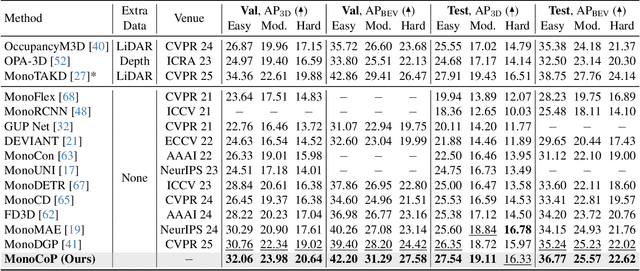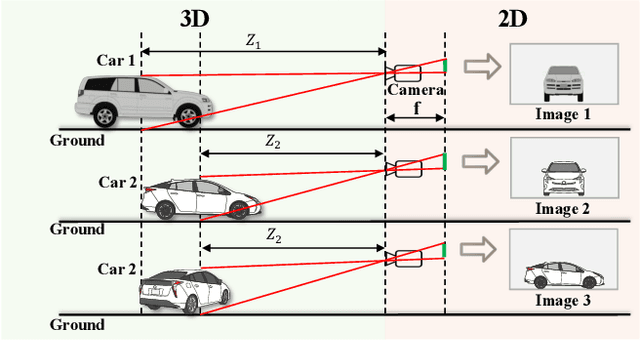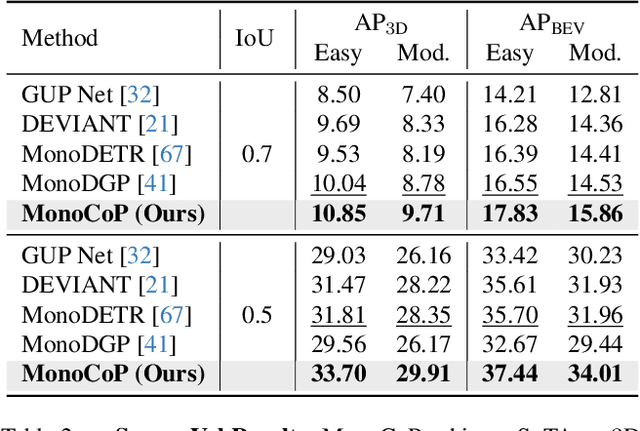Abhinav Kumar
Robotics Department, University of Michigan
Qonvolution: Towards Learning High-Frequency Signals with Queried Convolution
Dec 15, 2025Abstract:Accurately learning high-frequency signals is a challenge in computer vision and graphics, as neural networks often struggle with these signals due to spectral bias or optimization difficulties. While current techniques like Fourier encodings have made great strides in improving performance, there remains scope for improvement when presented with high-frequency information. This paper introduces Queried-Convolutions (Qonvolutions), a simple yet powerful modification using the neighborhood properties of convolution. Qonvolution convolves a low-frequency signal with queries (such as coordinates) to enhance the learning of intricate high-frequency signals. We empirically demonstrate that Qonvolutions enhance performance across a variety of high-frequency learning tasks crucial to both the computer vision and graphics communities, including 1D regression, 2D super-resolution, 2D image regression, and novel view synthesis (NVS). In particular, by combining Gaussian splatting with Qonvolutions for NVS, we showcase state-of-the-art performance on real-world complex scenes, even outperforming powerful radiance field models on image quality.
Terrarium: Revisiting the Blackboard for Multi-Agent Safety, Privacy, and Security Studies
Oct 16, 2025Abstract:A multi-agent system (MAS) powered by large language models (LLMs) can automate tedious user tasks such as meeting scheduling that requires inter-agent collaboration. LLMs enable nuanced protocols that account for unstructured private data, user constraints, and preferences. However, this design introduces new risks, including misalignment and attacks by malicious parties that compromise agents or steal user data. In this paper, we propose the Terrarium framework for fine-grained study on safety, privacy, and security in LLM-based MAS. We repurpose the blackboard design, an early approach in multi-agent systems, to create a modular, configurable testbed for multi-agent collaboration. We identify key attack vectors such as misalignment, malicious agents, compromised communication, and data poisoning. We implement three collaborative MAS scenarios with four representative attacks to demonstrate the framework's flexibility. By providing tools to rapidly prototype, evaluate, and iterate on defenses and designs, Terrarium aims to accelerate progress toward trustworthy multi-agent systems.
Diffusing Trajectory Optimization Problems for Recovery During Multi-Finger Manipulation
Oct 08, 2025Abstract:Multi-fingered hands are emerging as powerful platforms for performing fine manipulation tasks, including tool use. However, environmental perturbations or execution errors can impede task performance, motivating the use of recovery behaviors that enable normal task execution to resume. In this work, we take advantage of recent advances in diffusion models to construct a framework that autonomously identifies when recovery is necessary and optimizes contact-rich trajectories to recover. We use a diffusion model trained on the task to estimate when states are not conducive to task execution, framed as an out-of-distribution detection problem. We then use diffusion sampling to project these states in-distribution and use trajectory optimization to plan contact-rich recovery trajectories. We also propose a novel diffusion-based approach that distills this process to efficiently diffuse the full parameterization, including constraints, goal state, and initialization, of the recovery trajectory optimization problem, saving time during online execution. We compare our method to a reinforcement learning baseline and other methods that do not explicitly plan contact interactions, including on a hardware screwdriver-turning task where we show that recovering using our method improves task performance by 96% and that ours is the only method evaluated that can attempt recovery without causing catastrophic task failure. Videos can be found at https://dtourrecovery.github.io/.
Generalizing Monocular 3D Object Detection
Aug 27, 2025Abstract:Monocular 3D object detection (Mono3D) is a fundamental computer vision task that estimates an object's class, 3D position, dimensions, and orientation from a single image. Its applications, including autonomous driving, augmented reality, and robotics, critically rely on accurate 3D environmental understanding. This thesis addresses the challenge of generalizing Mono3D models to diverse scenarios, including occlusions, datasets, object sizes, and camera parameters. To enhance occlusion robustness, we propose a mathematically differentiable NMS (GrooMeD-NMS). To improve generalization to new datasets, we explore depth equivariant (DEVIANT) backbones. We address the issue of large object detection, demonstrating that it's not solely a data imbalance or receptive field problem but also a noise sensitivity issue. To mitigate this, we introduce a segmentation-based approach in bird's-eye view with dice loss (SeaBird). Finally, we mathematically analyze the extrapolation of Mono3D models to unseen camera heights and improve Mono3D generalization in such out-of-distribution settings.
Reliable Multi-view 3D Reconstruction for `Just-in-time' Edge Environments
Aug 21, 2025Abstract:Multi-view 3D reconstruction applications are revolutionizing critical use cases that require rapid situational-awareness, such as emergency response, tactical scenarios, and public safety. In many cases, their near-real-time latency requirements and ad-hoc needs for compute resources necessitate adoption of `Just-in-time' edge environments where the system is set up on the fly to support the applications during the mission lifetime. However, reliability issues can arise from the inherent dynamism and operational adversities of such edge environments, resulting in spatiotemporally correlated disruptions that impact the camera operations, which can lead to sustained degradation of reconstruction quality. In this paper, we propose a novel portfolio theory inspired edge resource management strategy for reliable multi-view 3D reconstruction against possible system disruptions. Our proposed methodology can guarantee reconstruction quality satisfaction even when the cameras are prone to spatiotemporally correlated disruptions. The portfolio theoretic optimization problem is solved using a genetic algorithm that converges quickly for realistic system settings. Using publicly available and customized 3D datasets, we demonstrate the proposed camera selection strategy's benefits in guaranteeing reliable 3D reconstruction against traditional baseline strategies, under spatiotemporal disruptions.
ReXGroundingCT: A 3D Chest CT Dataset for Segmentation of Findings from Free-Text Reports
Jul 29, 2025Abstract:We present ReXGroundingCT, the first publicly available dataset to link free-text radiology findings with pixel-level segmentations in 3D chest CT scans that is manually annotated. While prior datasets have relied on structured labels or predefined categories, ReXGroundingCT captures the full expressiveness of clinical language represented in free text and grounds it to spatially localized 3D segmentation annotations in volumetric imaging. This addresses a critical gap in medical AI: the ability to connect complex, descriptive text, such as "3 mm nodule in the left lower lobe", to its precise anatomical location in three-dimensional space, a capability essential for grounded radiology report generation systems. The dataset comprises 3,142 non-contrast chest CT scans paired with standardized radiology reports from the CT-RATE dataset. Using a systematic three-stage pipeline, GPT-4 was used to extract positive lung and pleural findings, which were then manually segmented by expert annotators. A total of 8,028 findings across 16,301 entities were annotated, with quality control performed by board-certified radiologists. Approximately 79% of findings are focal abnormalities, while 21% are non-focal. The training set includes up to three representative segmentations per finding, while the validation and test sets contain exhaustive labels for each finding entity. ReXGroundingCT establishes a new benchmark for developing and evaluating sentence-level grounding and free-text medical segmentation models in chest CT. The dataset can be accessed at https://huggingface.co/datasets/rajpurkarlab/ReXGroundingCT.
MonoCoP: Chain-of-Prediction for Monocular 3D Object Detection
May 08, 2025



Abstract:Accurately predicting 3D attributes is crucial for monocular 3D object detection (Mono3D), with depth estimation posing the greatest challenge due to the inherent ambiguity in mapping 2D images to 3D space. While existing methods leverage multiple depth cues (e.g., estimating depth uncertainty, modeling depth error) to improve depth accuracy, they overlook that accurate depth prediction requires conditioning on other 3D attributes, as these attributes are intrinsically inter-correlated through the 3D to 2D projection, which ultimately limits overall accuracy and stability. Inspired by Chain-of-Thought (CoT) in large language models (LLMs), this paper proposes MonoCoP, which leverages a Chain-of-Prediction (CoP) to predict attributes sequentially and conditionally via three key designs. First, it employs a lightweight AttributeNet (AN) for each 3D attribute to learn attribute-specific features. Next, MonoCoP constructs an explicit chain to propagate these learned features from one attribute to the next. Finally, MonoCoP uses a residual connection to aggregate features for each attribute along the chain, ensuring that later attribute predictions are conditioned on all previously processed attributes without forgetting the features of earlier ones. Experimental results show that our MonoCoP achieves state-of-the-art (SoTA) performance on the KITTI leaderboard without requiring additional data and further surpasses existing methods on the Waymo and nuScenes frontal datasets.
RICCARDO: Radar Hit Prediction and Convolution for Camera-Radar 3D Object Detection
Apr 12, 2025Abstract:Radar hits reflect from points on both the boundary and internal to object outlines. This results in a complex distribution of radar hits that depends on factors including object category, size, and orientation. Current radar-camera fusion methods implicitly account for this with a black-box neural network. In this paper, we explicitly utilize a radar hit distribution model to assist fusion. First, we build a model to predict radar hit distributions conditioned on object properties obtained from a monocular detector. Second, we use the predicted distribution as a kernel to match actual measured radar points in the neighborhood of the monocular detections, generating matching scores at nearby positions. Finally, a fusion stage combines context with the kernel detector to refine the matching scores. Our method achieves the state-of-the-art radar-camera detection performance on nuScenes. Our source code is available at https://github.com/longyunf/riccardo.
Do GFlowNets Transfer? Case Study on the Game of 24/42
Mar 03, 2025Abstract:Generating diverse solutions is key to human-like reasoning, yet autoregressive language models focus on single accurate responses, limiting creativity. GFlowNets optimize solution generation as a flow network, promising greater diversity. Our case study shows their limited zero-shot transferability by fine-tuning small and medium-sized large language models on the Game of 24 and testing them on the Game of 42 datasets. Results revealed that GFlowNets struggle to maintain solution diversity and accuracy, highlighting key limitations in their cross-task generalization and the need for future research in improved transfer learning capabilities.
LATTEO: A Framework to Support Learning Asynchronously Tempered with Trusted Execution and Obfuscation
Feb 07, 2025Abstract:The privacy vulnerabilities of the federated learning (FL) paradigm, primarily caused by gradient leakage, have prompted the development of various defensive measures. Nonetheless, these solutions have predominantly been crafted for and assessed in the context of synchronous FL systems, with minimal focus on asynchronous FL. This gap arises in part due to the unique challenges posed by the asynchronous setting, such as the lack of coordinated updates, increased variability in client participation, and the potential for more severe privacy risks. These concerns have stymied the adoption of asynchronous FL. In this work, we first demonstrate the privacy vulnerabilities of asynchronous FL through a novel data reconstruction attack that exploits gradient updates to recover sensitive client data. To address these vulnerabilities, we propose a privacy-preserving framework that combines a gradient obfuscation mechanism with Trusted Execution Environments (TEEs) for secure asynchronous FL aggregation at the network edge. To overcome the limitations of conventional enclave attestation, we introduce a novel data-centric attestation mechanism based on Multi-Authority Attribute-Based Encryption. This mechanism enables clients to implicitly verify TEE-based aggregation services, effectively handle on-demand client participation, and scale seamlessly with an increasing number of asynchronous connections. Our gradient obfuscation mechanism reduces the structural similarity index of data reconstruction by 85% and increases reconstruction error by 400%, while our framework improves attestation efficiency by lowering average latency by up to 1500% compared to RA-TLS, without additional overhead.
 Add to Chrome
Add to Chrome Add to Firefox
Add to Firefox Add to Edge
Add to Edge